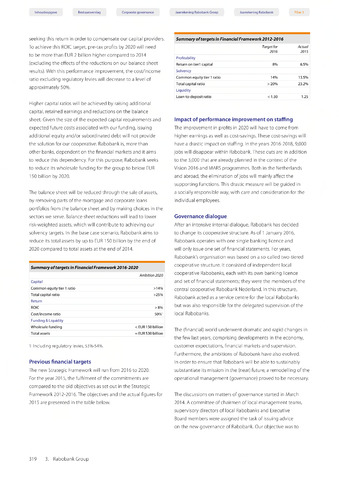Inhoudsopgave Bestuursverslag Corporate governance
seeking this return in order to compensate our capital providers.
To achieve this ROIC target, pre-tax profits by 2020 will need
to be more than EUR 2 billion higher compared to 2014
(excluding the effects of the reductions on our balance sheet
results). With this performance improvement, the cost/income
ratio excluding regulatory levies will decrease to a level of
approximately 50%.
Higher capital ratios will be achieved by raising additional
capital, retained earnings and reductions on the balance
sheet. Given the size of the expected capital requirements and
expected future costs associated with our funding, issuing
additional equity and/or subordinated debt will not provide
the solution for our cooperative. Rabobank is, more than
other banks, dependent on the financial markets and it aims
to reduce this dependency. For this purpose, Rabobank seeks
to reduce its wholesale funding for the group to below EUR
150 billion by 2020.
The balance sheet will be reduced through the sale of assets,
by removing parts of the mortgage and corporate loans
portfolios from the balance sheet and by making choices in the
sectors we serve. Balance sheet reductions will lead to lower
risk-weighted assets, which will contribute to achieving our
solvency targets. In the base case scenario, Rabobank aims to
reduce its total assets by up to EUR 150 billion by the end of
2020 compared to total assets at the end of 2014.
Summary of targets in Financial Framework 2016-2020
Ambition 2020
Capital
Common equity tier 1 ratio
>14%
Total capital ratio
>25%
Return
ROIC
>8%
Cost/income ratio
50%1
Funding Liquidity
Wholesale funding
EUR 150 billion
Total assets
EUR 530 billion
1: Including regulatory levies, 53%-54%.
Previous financial targets
The new Strategic Framework will run from 2016 to 2020.
For the year 2015, the fulfilment of the commitments are
compared to the old objectives as set out in the Strategic
Framework 2012-2016. The objectives and the actual figures for
2015 are presented in the table below.
Jaarrekening Rabobank Groep Jaarrekening Rabobank
Summary of targets in Financial Framework2012-2016
Target for
Actual
2016
2015
Profitability
Return ontierl capital
8%
6.5%
Solvency
Common equity tier 1 ratio
14%
13.5%
Total capital ratio
20%
23.2%
Liquidity
Loan-to-deposit ratio
1.30
1.25
Impact of performance improvement on staffing
The improvement in profits in 2020 will have to come from
higher earnings as well as cost-savings.These cost-savings will
have a drastic impact on staffing. In the years 2016-2018, 9,000
jobs will disappear within Rabobank.These cuts are in addition
to the 3,000 that are already planned in the context of the
Vision 2016 and MARS programmes. Both in the Netherlands
and abroad, the elimination of jobs will mainly affect the
supporting functions. This drastic measure will be guided in
a socially responsible way, with care and consideration for the
individual employees.
Governance dialogue
After an intensive internal dialogue, Rabobank has decided
to change its cooperative structure. As of 1 January 2016,
Rabobank operates with one single banking licence and
will only issue one set of financial statements. For years,
Rabobank's organisation was based on a so-called two-tiered
cooperative structure. It consisted of independent local
cooperative Rabobanks, each with its own banking licence
and set of financial statements; they were the members of the
central cooperative Rabobank Nederland. In this structure,
Rabobank acted as a service centre for the local Rabobanks
but was also responsible for the delegated supervision of the
local Rabobanks.
The (financial) world underwent dramatic and rapid changes in
the few last years, comprising developments in the economy,
customer expectations, financial markets and supervision.
Furthermore, the ambitions of Rabobank have also evolved.
In order to ensure that Rabobank will be able to sustainably
substantiate its mission in the (near) future, a remodelling of the
operational management (governance) proved to be necessary.
The discussions on matters of governance started in March
2014. A committee of chairmen of local management teams,
supervisory directors of local Rabobanks and Executive
Board members were assigned the task of issuing advice
on the new governance of Rabobank. Our objective was to
319 3. Rabobank Group

